|
|
Created/dedicated as per personal communication with Betsy Higgins, September, 25, 2011
Updated as per James P. Tuttle's The Hawk Moths of North America, September 25, 2011
|
West Central Texas
Sphingidae
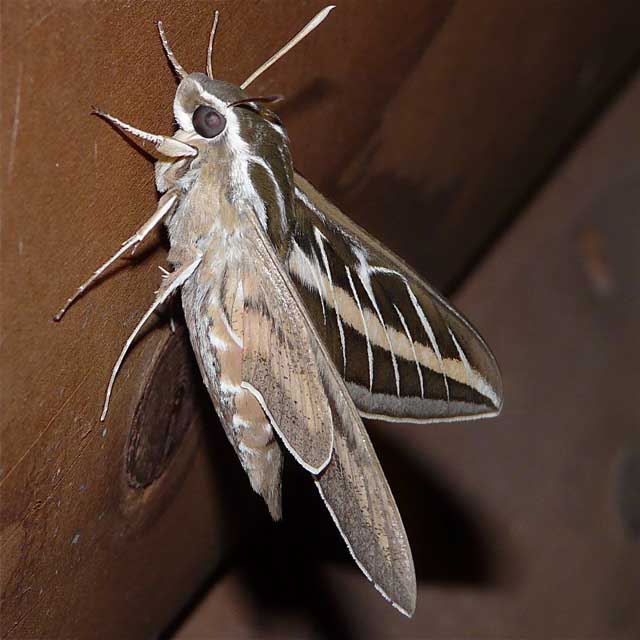
Hyles lineata, Concan, Uvalde County, Texas, April 19, 2008, courtesy of
Betsy Higgins.
This page is inspired by and dedicated to
Betsy Higgins who sent me the pictures of
Hyles lineata from Concan (Uvalde County) at the top and bottom
of this page.
Betsy has also sent a picture of Eumorpha vitis from the same location.
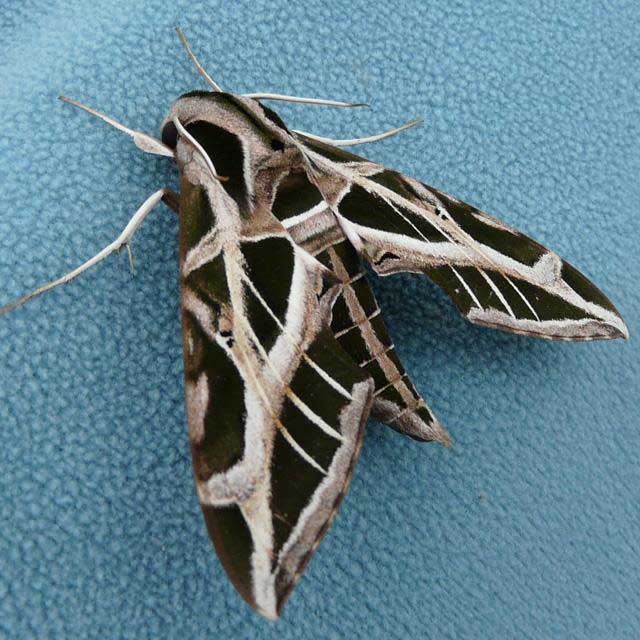
Eumorpha vitis, Concan, Uvalde County, Texas,
April 20, 2008, courtesy of Betsy Higgins.
Seventy-five Sphingidae species are listed for Texas on the U.S.G.S.
website (now BAMONA). Not all of the species are reported or anticipated in
the West Central region.
It is hoped
that this checklist, with the thumbnails and notes, will help you
quickly identify the moths you are likely to encounter.
Please note that I have no confirmations for these moths in West Central Texas, unless specifically indicated.
Please help me develop this list with improved, documented accuracy
by sending sightings (species, date, location), preferably with an
electronic image, via email to
Bill Oehlke.
Please also send yor sightings to BAMONA, an excellent online resource.
The night-blooming moon flower will attract many
Sphingidae at dusk and into the night.
Sphinginae subfamily
Sphingini tribe:
 |
Agrius cingulata,
Pink-spotted hawkmoth.
This species is a strong migrant and adults nectar from
deep-throated flowers including moonflower (Calonyction aculeatum),
morning glory (Convolvulus), honey suckle (Lonicera)
and petunia (Petunia species).
|
 |
I suspect if you grow tomatoes, you are likely to encounter Manduca quinquemaculata.
|
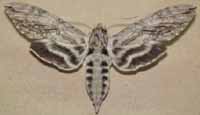 |
The upperside of the forewing is pale gray with a yellowish tint,
wavy black lines and dashes, and inconspicuous white spots.
|
 |
Look for three large yellow spots
on each side of the abdomen. The upperside of the forewing is
yellowish brown to deep chocolate brown with a dusting of white
scales and zigzagged black and white lines.
|
 |
If you grow tomatoes, you have probably encountered Manduca sexta
in the larval stage.
Larvae get very large and can strip a tomato plant.
|
 | Sphinx dollii (Wing span: 1 3/4 - 2 1/2 inches (4.5 - 6.3 cm)),
flies in arid brushlands and desert foothills from Nevada and
southern California east through Utah,
Arizona, Colorado, and New Mexico to Oklahoma and Texas.
|
 | The upperside of the forewing is pale blue-gray to dark gray with a black dash reaching the wing tip and
a white stripe along the lower outer margin.
The upperside of the hindwing is black with two diffuse white
bands, the upper one being practically non-existent.
|
Smerinthini Tribe:
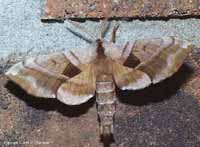 |
Amorpha juglandis,
the Walnut Sphinx.
The adults are also highly variable; sometimes wings of an individual
may be all one color or may have several colors, ranging from pale to
dark brown, and may have a white or pink tinge. Patterns range from
faint to pronounced.
See the file for the female; she is different.
|
 |
They are common on Prince Edward Island, and are
|
Macroglossinae subfamily
Dilophonotini tribe:
 |
During the night adults nectar at flowers, including bouncing bet
(Saponaria officinalis) and Asystasia gangetica beginning at dusk.
July and August are flight times in the southern states.
rare
|
 |
Hemaris diffinis, the
Snowberry Clearwing or Bumblebee Moth.
Adults mimic bumblebees and are quite variable. The wings are basically clear, with dark brown to
brownish-orange veins, bases and edges. The thorax is golden-brown to
dark greenish-brown. The abdomen tends to be dark (black) with 1-2
yellow segments before the tip.
|
Philampelini tribe:
 |
Larvae get large and feed on grape vines and Virginia creeper.
Note the differences between this moth and the Pandorus Sphinx. |
 |
Eumorpha vitis,
the Vine Sphinx
The upperside of the moth is dark pinkish brown. Each forewing has a
lighter brown band along the costa, and sharp pinkish white bands and
streaks. The hindwing has a pink patch on the inner margin.
Note large brown parallelogram between lowest striga
up to transverse lines.
|
Eumorpha vitis, Concan, Uvalde County, April 20, 2008, courtesy of Betsy Higgins.
Macroglossini tribe:
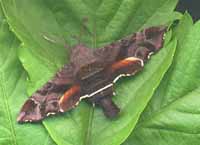 |
Amphion floridensis,
the Nessus Sphinix
This day flier is widely distributed. If you have Virginia Creeper, you
probably have the Nessus Sphinx. Two bright, distinct, narrow yellow
bands are often visible on the abdomen.
|
 |
Darapsa myron, the Virginia Creeper Sphinx or the Grapevine Sphinx
If you have the
foodplants indicated in the common names, you probably have this
species nearby. The lower wings are orange. |
 |
Hyles lineata
BH, the White-lined Sphinx
This species has
strong migrating tendancies from much further south.
There are records from New Hampshire and Maine. |
Hyles lineata, Concan, Uvalde County, April 19, 2008, Betsy Higgins
 |
The rare and possibly endangered Proud Sphinx flies from Texas and
Louisiana east to northern Florida, north to Alabama, Missouri,
northern Georgia, and South Carolina. rare
|
 |
The upperside of the forewing is pale gray-green with a deep
green-brown median area and a white dash at the wing tip.
rare
|
|
|
|
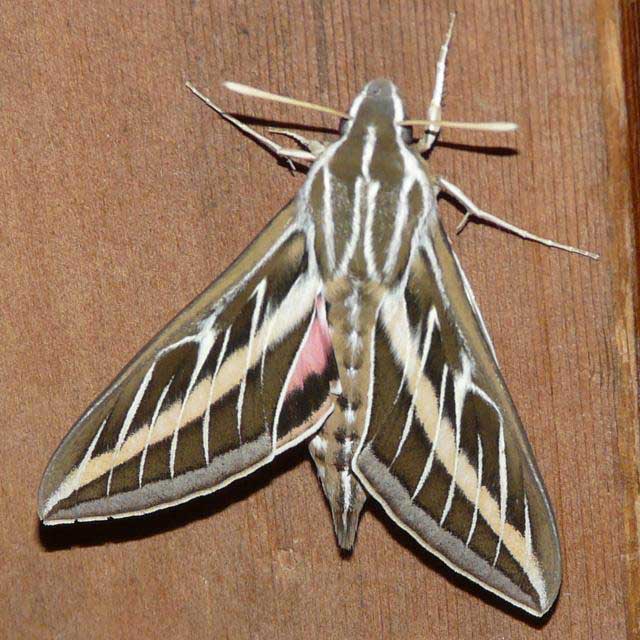
Hyles lineata, Concan, Uvalde County, Texas, April 19, 2008, courtesy of
Betsy Higgins.
Enjoy some of nature's wonderments, giant silk moth cocoons.
These cocoons are for sale winter and fall. Beautiful Saturniidae moths will emerge the following spring and summer.
Read Actias luna rearing article. Additional online help available.
Use your browser "Back" button to return to the previous page.
This page is brought to you by
Bill Oehlke and the
WLSS. Pages are on space rented from Bizland. If you would like
to become a "Patron of the Sphingidae Site", contact Bill.
Please send sightings/images to Bill. I will do my best to respond to
requests for identification help.
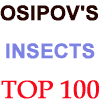 | 
Show appreciation for this site by clicking on flashing butterfly to the left.
The link will take you to a page with links to many insect sites. |
This website has been created and is maintained by Bill Oehlke without government or institutional financial assistance. All expenses, ie., text reference
support material, webspace rental from Bizland, computer repairs/replacements, backups systems, software for image adjustments (Adobe Photoshop; L-View),
ftp software, anti-virus protection, scanner, etc. are my own.
I very much appreciate all the many images that have been sent to me, or of which I have been granted permission to copy and post from other websites.
All images on this site remain the property of respective photographers.
If you would like to contribute to the maintenace of this website by sending a contribution to
Bill Oehlke
Box 476
155 Peardon Road
Montague, Prince Edward Island, C0A1R0
Canada
your donation would be much appreciated and would be used for
1) paying for webspace rental;
2) paying for computer maintenance and software upgrades;
3) purchases of additional text reference material (journals and books) in anticipation of expanding the site to a worldwide Sphingidae site;
4) helping to pay my daughter's tuition; with anything left over going to humanitarian aid.
If you are mailing a check from USA, please use $0.85 postage. Donations can also be made through Paypal via the button below.




